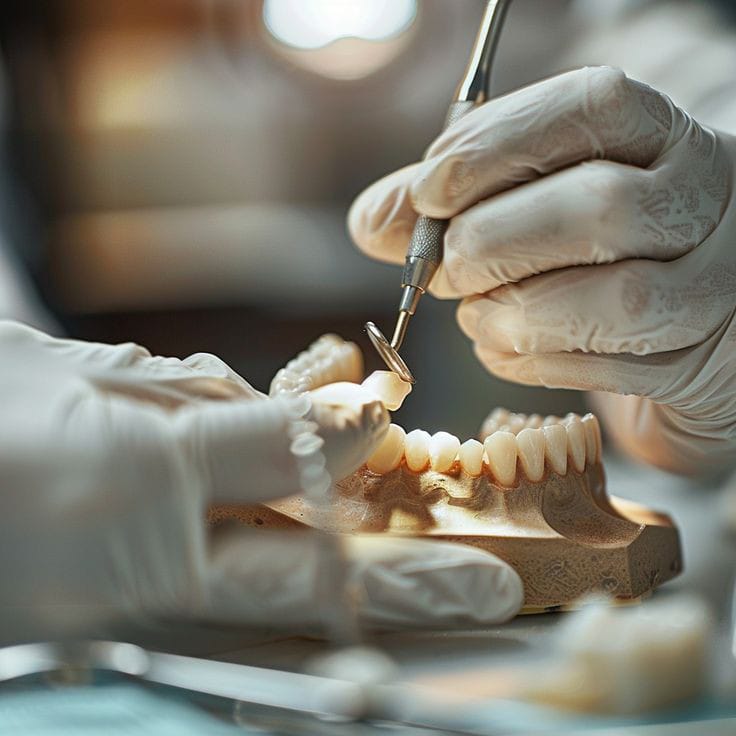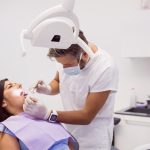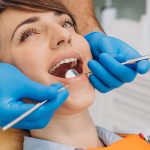
Prosthodontics
Prosthodontics is a branch of dentistry dedicated to making replacements for missing or damaged
teeth. Common prosthodontic treatments include dentures, dental implants, crowns and bridges.
A prosthodontist (a type of dental specialist) receives extended training in the fabrication of
crowns, bridges, dentures and other restorative treatments. They also routinely treat TMJ
disorders.
Who needs prosthodontics?
Prosthodontics can treat a wide range of issues. Your general dentist might refer you to a
prosthodontist if you have:
- Missing teeth.
- Severely damaged teeth.
- TMJ pain or dysfunction.
- Mouth or facial pain.
- Cosmetic concerns.
- Obstructive sleep apnea.
What is a prosthodontic appliance?
There are many types of fixed and removable prosthodontic appliances, including:
- Full and partial dentures.
- Crowns and bridges.
- Oral splints.
- Night guards for TMJ disorder and sleep apnea.
Procedure Details
What are some examples of prosthodontic treatments?
Many dental treatments are prosthodontic in nature. Your general dentist may offer many of
these procedures. But they’ll likely refer you to a prosthodontist if your case is complex or if
they need to coordinate treatment.
Dental crowns
A dental crown — sometimes called a “cap” — is a restoration that covers a badly damaged
tooth. You might need a crown if you have extensive decay or a cracked tooth, or if you’ve
recently had a root canal.
Dental bridges
A dental bridge replaces one or more missing teeth in a row. This dental prosthetic consists of
two crowns on either side with artificial teeth (pontics) in between them. Once placed, your
natural teeth anchor the crowns, and the pontics fill the gap in your smile.
Dentures
There are two main types of dentures: partial and full. Partial dentures replace several
sporadically missing teeth. Full dentures replace a full arch of missing teeth. These removable
appliances help restore the function and appearance of your smile.
Inlays and onlays
If a tooth is too damaged for a filling but not damaged enough to warrant a crown, then you
might need an inlay or onlay. These custom restorations fit into your tooth structure like tiny
puzzle pieces.
Dental implants
Dental implants are tiny threaded posts used to replace missing teeth roots. They’re made from
surgical-grade titanium or ceramic. Your dental provider places them into your jawbone. Once
your implants heal, a prosthodontist can restore them with crowns, bridges or dentures.
If you’re missing most or all of your teeth, there are several removable and nonremovable
implant-supported options. Talk to your dentist or prosthodontist to find out which treatment is
best for you.
Risks / Benefits
What are the advantages of prosthodontics?
Prosthodontic treatments can:
- Repair badly damaged teeth.
- Replace missing teeth.
- Improve your bite (the way your teeth fit together).
- Correct TMJ issues.
What are the risks of prosthodontics?
Risks are minimal when it comes to undergoing prosthodontic procedures. Like any dental
procedure, there’s always a small risk of infection or nerve damage.
If you notice any warning signs, such as fever or drainage near the treatment site, contact your
dentist or prosthodontist right away.
When should I see my healthcare provider?
If you have damaged or missing teeth that interfere with your quality of life, make an
appointment with a dentist. They can discuss your treatment options with you and tell you
whether you need to see a prosthodontist.
If you’ve recently undergone prosthodontic treatment, be sure to call your provider if you notice
signs of infection, such as fever, drainage, pain or swelling that doesn’t go away with medication









